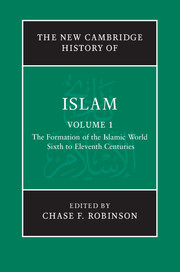Book contents
- Frontmatter
- Introduction
- PART I THE LATE ANTIQUE CONTEXT
- PART II UNIVERSALISM AND IMPERIALISM
- PART III REGIONALISM
- 10 Arabia
- 11 The Islamic east
- 12 Syria
- 13 Egypt
- 14 The Iberian Peninsula and North Africa
- PART IV THE HISTORIOGRAPHY OF EARLY ISLAMIC HISTORY
- Conclusion: From formative Islam to classical Islam
- Glossary
- Bibliography
- Index
- Plate Section
- References
14 - The Iberian Peninsula and North Africa
from PART III - REGIONALISM
Published online by Cambridge University Press: 28 March 2011
- Frontmatter
- Introduction
- PART I THE LATE ANTIQUE CONTEXT
- PART II UNIVERSALISM AND IMPERIALISM
- PART III REGIONALISM
- 10 Arabia
- 11 The Islamic east
- 12 Syria
- 13 Egypt
- 14 The Iberian Peninsula and North Africa
- PART IV THE HISTORIOGRAPHY OF EARLY ISLAMIC HISTORY
- Conclusion: From formative Islam to classical Islam
- Glossary
- Bibliography
- Index
- Plate Section
- References
Summary
The expansion in the west
The Arab conquests in North Africa began soon after the fall of Alexandria to the army commanded by ʿAmr ibn al-ʿĀṣ in 21/642. Unlike previous expansion in the Near East, the march westwards of the Arab soldiers was not marked by sweeping victories and the resigned acquiescence of the conquered populations. Widespread revolts, crushing defeats and hasty evacuations of recently conquered territories fill the terse accounts of the few Arab sources that provide some information on this huge area. In contrast, the narrative of the conquest of Hispania in 92/711 recalls a similar pattern to the invasions in Byzantine and Sasanian territories: after one pitched battle and the defeat of the king’s army the Visigothic administration crumbled, clearing the way for an Arab rule which consolidated with remarkable ease and no serious challenges.
The resistance met by the conquerors in the southern Mediterranean was due to the political and social diversity of the region. In the land extending from Alexandria to Tangier the Arabs did not meet one single enemy, but rather a number of enemies whose actions and motivations were diverse, and not always comprehensible to modern historians. Arguably, the main opponent of the invading armies was the Byzantine empire, whose foothold in North Africa went back to the times when, in 534, the generals of the emperor Justinian conquered the Vandal kingdom.
Keywords
- Type
- Chapter
- Information
- The New Cambridge History of Islam , pp. 581 - 622Publisher: Cambridge University PressPrint publication year: 2010
References
- 4
- Cited by



